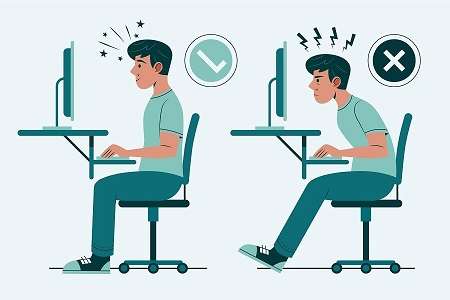Posture refers to the body’s Position when standing, sitting, or lying down. It is the alignment of the various body parts concerning each other and gravity. A straight, neutral spine, relaxed shoulders, and balanced weight distribution on the feet or buttocks characterize Good Posture. On the other hand, poor Posture can lead to musculoskeletal problems, such as back pain, neck pain, headaches, and overall well-being and well-being. Maintaining Good Posture is essential for optimal body function and preventing postural problems.
Table of Contents

Read More: Read more about Text Neck Disorder And Mobile Phone Addiction
Types of Posture
Several types of Postures can be classified based on their alignment and Position. Some of the common types of poses include:
- Neutral Posture: This ideal Posture is characterized by a straight and neutral spine, relaxed shoulders, and a balanced weight distribution on the feet or buttocks.
- Kyphosis is a postural deviation characterized by a rounded upper back and shoulders and a forward head Posture.
- Lordosis: This is a postural deviation characterized by an excessive inward curve of the lower back, which can result in a protruding abdomen and a forward tilt of the pelvis.
- Scoliosis is a postural deviation characterized by an abnormal lateral curvature of the spine, which can result in an asymmetrical shoulder or hip alignment.
- Forward head Posture: This is a postural deviation characterized by a protruding chin and a forward position of the head, which can lead to neck pain and headaches.
- Rounded shoulders: This is a postural deviation characterized by a forward and round position of the shoulders, which can lead to upper back pain and shoulder impingement.
- Flat back Posture: This is a postural deviation characterized by a loss of the normal curvature of the lower back, which can result in a flattened spine appearance and a forward head Posture.
It is important to note that postural deviations can vary in severity and result from various factors such as poor ergonomics, muscle imbalances, and injury. Maintaining Good Posture and addressing any postural problems early is essential to prevent musculoskeletal problems and improve overall well-being and well-being.
Best Sitting Posture
Good sitting Posture involves maintaining a neutral spine, proper alignment of the head and shoulders, and evenly distributed weight on the hips and thighs. Here are some tips for maintaining Good sitting Posture:

- Sit with your back aligned and your shoulders calm.
- Keep your feet flat on the ground, and your knees bent at a 90-degree angle.
- Keep your hips and thighs parallel to the ground and distribute your weight evenly on both hips.
- Align your ears, shoulders, and hips in a vertical line.
- Avoid crossing your legs or ankles, leading to poor circulation and discomfort.
- Keep your computer screen at eye level to Avoid straining your neck and shoulders.
- Take regular breaks and stretch your legs and back to Avoid prolonged sitting.
- Use a supportive chair with adjustable height and backrest.
You can reduce the risk of back pain, neck pain, and other musculoskeletal problems by practising Good sitting Posture. Good Posture can also help improve your breathing, digestion, and concentration and boost your energy and productivity.
Best Standing Posture
A straight and neutral spine, relaxed shoulders, and a balanced weight distribution on the feet characterize an excellent standing Posture. Here are some tips for maintaining a Good upright Posture:

- Stand straight with feet shoulder-width apart and weight evenly distributed on both feet.
- Keep your shoulders relaxed and Avoid rounding them forward or tensing them upward.
- Pull your shoulder blades down and back to keep your chest open.
- Tuck your chin slightly to keep your head neutral without jutting it forward.
- Engage your body’s muscles to stabalize your spine and Avoid excessive arching or leaning backwards.
- Keep your knees slightly bent to Avoid locking them, and maintain a relaxed Posture.
- Wear comfortable shoes that provide adequate support and cushioning for your feet.
- Take regular breaks and move around to Avoid prolonged standing, which can cause fatigue and discomfort.
By practicing Good standing Posture, you can reduce the risk of musculoskeletal problems, such as back pain, neck pain, and fatigue, and improve your overall well-being.
Best Lying Posture
Good lying Posture involves maintaining proper head, neck, spine, and hips alignment and Avoiding long or awkward Positions that can lead to discomfort and pain. Here are some tips for maintaining Good lying pose:

- Use a supportive mattress and pillow that conform to your body shape and preferences.
- Avoid sleeping on your stomach, as it can strain your neck and spine.
- Sleep on your back or side, with a pillow under your knees if you are a back sleeper, or between your knees, if you are a side sleeper.
- Keep your spine neutral, and Avoid twisting or bending your neck or hips.
- Avoid tucking your chin in or letting it jut out, as it can strain your neck and upper back.
- Avoid sleeping with your arms overhead or under your head, as it can compress your shoulders and neck.
- Use a neck pillow or cervical roll if you have neck pain or stiffness.
- Avoid using electronic devices or watching TV in bed, as it can interfere with sleep quality.
By practicing Good lying alignment, you can reduce the risk of back pain, neck pain, and other musculoskeletal problems associated with poor sleeping habits. Good pose can also help improve your sleep quality and overall well-being and well-being.
Best Walking Posture
Good walking Posture involves maintaining a neutral spine, relaxed shoulders, and a balanced gait. Here are some tips for maintaining Good walking Posture:

- Stand up straight with your head held high and your shoulders relaxed and down.
- Keep your chin parallel to the ground and Avoid looking down at your feet.
- Engage your core muscles and maintain a slight forward tilt of your pelvis.
- Swing your arms naturally at your sides without crossing them in front of your body.
- Step out with your heel first and roll your foot forward onto the ball and then onto the toes.
- Keep your feet pointed straight ahead and Avoided turning them inward or outward.
- Take smooth, even strides without overstriding or shuffling your feet.
- Wear comfortable shoes with good arch support and cushioning.
Maintaining Good walking alignment can improve your balance, reduce the risk of falls, and alleviate stress on your joints and muscles. Walking with Good pose can also help increase your energy levels, reduce fatigue, and improve your overall well-being and well-being.
Best Mobile Using Posture
Good mobile phone Posture involves maintaining proper head, neck, and shoulder alignment and Avoiding prolonged or repetitive movements that can lead to discomfort and pain. Here are some tips for maintaining Good mobile phone pose:

- Hold your phone at eye level to Avoid bending your neck and looking down for prolonged periods.
- Keep your shoulders relaxed and down, and Avoid hunching forward.
- Use both hands to hold your phone, or use a phone stand or holder to Avoid maintaining it for long periods.
- Take regular breaks and stretch your neck, shoulders, and arms to Avoid fatigue and strain.
- Avoid using your phone in bright or dim light conditions that strain your eyes.
- Use voice recognition software or a hands-free device to Avoid repetitive typing and reduce the risk of carpal tunnel syndrome.
- Maintain a comfortable grip on your phone and Avoid gripping it too tightly or for prolonged periods.
- Use a larger font size and adjust the brightness and contrast to reduce eye strain.
By practising Good mobile phone Posture, you can reduce the risk of neck, shoulder, and other musculoskeletal problems associated with prolonged phone use. Good pose can also help improve your Posture and overall well-being and well-being.
Best Computer Using Posture
Good computer Posture involves maintaining proper head, neck, shoulders, arms, and wrists alignment and avoiding prolonged or repetitive movements that can lead to discomfort and pain. Here are some tips for maintaining Good computer pose:

- Sit with your back aligned, and your shoulders relaxed.
- Keep your feet flat on the ground, and your knees bent at a 90-degree angle.
- Keep your hips and thighs parallel to the ground and distribute your weight evenly on both hips.
- Align your ears, shoulders, and hips in a vertical line.
- Place your monitor at eye level, at least an arm’s length away, and tilt it slightly upward to Avoid bending your neck.
- Use an adjustable chair and desk to ensure proper height and comfort.
- Use good keyboard and mouse strain on your wrists and hands.
- Take regular breaks and stretch your neck, shoulders, arms, and wrists to Avoid fatigue and strain.
By practising Good computer Posture, you can reduce the risk of back pain, neck pain, and other musculoskeletal problems associated with prolonged computer use. Good Posture can also help improve your breathing, digestion, and concentration and boost your energy and productivity.

One Response